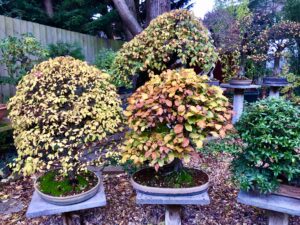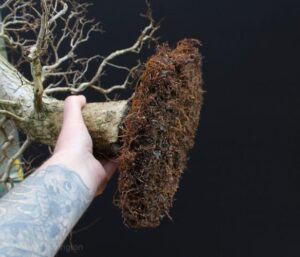Newly collected trees taken from the wild (yamadori), or gardens and hedges, have one thing in common with very weak bonsai. They have weak and/or poorly functioning rootballs. In the case of newly collected trees in particular, a huge percentage of the overall rootmass will have been left in the ground. The requirements of trees such as these are very different to those of established and healthy bonsai, and getting the soil conditions absolutely right makes a major difference to whether the tree survives.
This article does not describe what is the ‘best’ bonsai soil. There is a huge variation in growing conditions and climates across the world and from country to country, as well as variations in the requirements of different tree species. However, this article does describe the soil(s) I use for recovering newly collected, predominantly deciduous species in Northern Europe and some of the conditions I use, based on many years of collecting yamadori as well as ‘treating’ weak/sick bonsai.
The ‘ingredients’ for my soil are not necessarily available in shops however they can be sourced online with ease, using Google searches. The time spent doing this will reward you with trees that recover and bounce back into health!
.jpg)
Prepared soil mix for newly collected and/or weak trees (left) and a fast draining soil mix for bonsai (right).
I like to pre-mix the soil I will use for potting up newly collected trees. This ensures that I have enough soil in the garden ready for new trees, and also allows the soil-mix to ‘brew’ ready for use.
The soil-mix is based on large-grain horticultural pumice, in large 8kg bags that are then sieved into 7-15mm grains (above left) and 2-7mm grains (above right). I use the largest grains for weak and/or newly collected trees, topped off by a shallow layer of the smaller 2-7mm grains. The 2-7mm grains are also used for healthy bonsai, with species such as Olive, Pine and Juniper that require a drier, fast draining mix.
Pumice has been used for many years by yamadori collectors for its ability to hold water and importantly, a lot of oxygen. The large granules ensure that drainage is especially fast, something that is vitally important when placing a tree into the soil that has very limited uptake of moisture from its newly collected (weak) rootsystem. Smaller grains are more water-rententive and can remain wet for too long if the root system of a tree is inefficient.
Large grains of pumice will leave very small air-pockets between individual grains, and the release of moisture from each grain creates a tiny void of very humid air that new adventitious roots love to grow into. It is these voids of humidity that give a collecting mix the edge over ordinary bonsai soil mixes.
.jpg)
1) Approximately 20% chopped bark 5-15mm. At the time of writing (November 2018), I use a product in the UK known as ‘Melcourt Potting Bark’ and sift it to remove smaller pieces.
2) Approximately 20% shredded sphagnum moss. I collect sphagnum moss from the area that I collect my trees from, cut it up very finely and add it to the soil mix. Sphagnum has long been used as a very useful aid to encouraging strong rooting in trees.
3) (Optional) A handful of Biochar (Activated Charcoal). Available online and in garden centres, activated charcoal has long been claimed to keep soil ‘sweet’ although there is some debate as to its true worth as a soil component. Biochar has additional ingredients such as seaweed, rice water and molasses that are a microbe haven and introduce a huge array of beneficial bacteria and fungi into the soil mix as a whole.
4) Chalk/Groundsoil (Optional). The vast majority of the groundsoil from around the rootball of the trees I collect will fall away at the time of digging the tree. Essentially, the trees are ‘bare-rooted’ (but never washed). In these cases I introduce a small amount of the groundsoil, and pieces of the chalk bedrock that my trees grew on top of. This re-introduces useful bacteria and fungi from the actual collecting-site into the soil mix.
5) Cannazym (Optional). A product from the manufacturers of Rhizotonic, that is watered into the soil-mix. Cannzym prepares the soil, ready for newly collected trees, helping to colonise the soil mix with beneficial micro-organisms.
.jpg)
.jpg)
.jpg)
These three images compare the three different mixes I currently use for all of my trees and bonsai; 1) shows my collecting mix, as described in this article, with 7-15mm pumice grains. 2) Shows my medium grain mix (2-7mm pumice grains) for coniferous species and also as a topping for newly collected trees. 3) My mix for my healthy, refined deciduous bonsai contains small grains to encourage finer growth and ramification. It contains molar (sold as cat-litter), pumice and chopped bark with a grain size of 1-3mm. I then use a surface dressing of Akadama, primarily for its natural appearance.
Newly collected yamadori Hawthorn
Newly collected yamadori Hawthorn
Potting up and aftercare for newly collected and/or weak bonsai
The ideal container for newly collected trees is well-aerated and just big enough for the rootball to fit without unnecessary removal of roots. Milk crates or bread-baskets and wooden boxes are ideal for maximum airflow around the rootball. I also use plastic half-pots that have a relatively large surface area and use less soil for the shallow-rooted trees I often collect.
I apply an application of a product called Rhizotonic after potting up to encourage rooting, and then every 2-3 weeks for the following year.
The absolute ideal placement for newly collected deciduous trees (which is predominantly what I collect in the area of the UK that I live in) is away from frosts and rain, in a sunny position until leaf-burst, at which point shading is required for the remainder of the growing season. Soil heating via a soil-warming cable from the time of collection until leaf-burst is extremely advantageous as it increases warmth and humidity around the roots, encouraging them to grow.
A successful method of aftercare started by Spanish yamadori collectors is to place the entire tree, and its container, into a thin/cheap black binbag. This creates very humid conditions around the tree and some protection from the cold as well as wind and rain. Keep the tree inside the bin bag until after it comes into leaf. The humid atmosphere inside the bag will reduce transpiration/moisture loss from the leaves.
Has it survived?
Newly collected UK natives such as blackthorn, hawthorn and oak will nearly always come into leaf during the months after collection. However, they are able to do this using the stored sugars in their trunks and it is not indictive of survival. Trees that have not successfully begun to produce new roots will suffer a collapse of their new leaves and shoots around midsummer as temperatures rise. Never purchase a newly collected tree that has not successfully made it through the heat of the summer!
Yamadori that do suffer this collapse of new growth should not be discarded. It is not unusual for them to successfully bud out again once temperatures drop in late Summer and go on to survive.
The importance of using high quality bonsai soil mixes in the confines of a bonsai pot cannot be overestimated. For healthy and vigorous trees, use the best possible substrates, available from our store!

.JPG)
.JPG)




